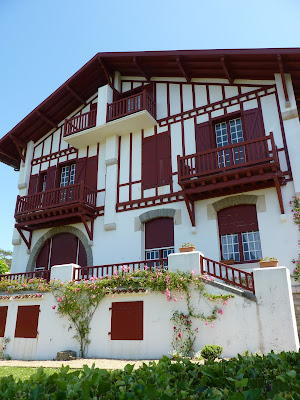 |
| Talia walking in St. Jean-de-Luz |
After spending a night in a quant bed & breakfast surrounded by vineyards about an hour outside of Bordeaux, we took a few days to explore
Le Pays Basque (the French Basque Country) in the southwestern corner of France. We based ourselves in Saint Jean-de-Luz, a pretty seaside resort town only a few miles from the Spanish border. The town made its wealth mainly from fishing and the capture of vessels on behalf of the French crown (a kind of dignified piracy). The town reached its peak in 1660, when it hosted the royal wedding between King Louis XIV of France and Maria-Teresa, Infanta of Spain. It's too bad I had other plans that day. The town still has an active fishing industry (mostly tuna, sardines and anchovies), but it's also made a fine living from tourism since the late 19th century. In the 1920s, H.G. Wells, Aldous Huxley and others built luxurious villas here. It's an elegant and attractive place, with a relaxed vibe, plenty of shopping, distinctive red-and-white Basque architecture, fine sandy beaches, a sweeping waterfront promenade, and a lively port packed with restaurants, bars and cafes. The local cuisine is excellent, with a good bit of Spanish influence. And at Jeremy's insistence, we even found a top-notch sushi joint (at least you know it's fresh).
 |
| The small Basque town of Sare |
A short drive away from Saint Jean-de-Luz are the charming Basque towns of Sare, Ainhoa and Saint Jean-Pied-de-Port. Basque culture is still alive and well here, and we had fun hopelessly trying to decipher the signs in Basque, a language which seems unconnected to any other tongue on earth.
In centuries past, Ainhoa made its living charging tolls to traders and religious pilgrims traveling between Spain and France. Given the town's strategic location, it's not surprising that Ainhoa has witnessed its share of military altercations over the years. During World War II, the town was part of a vital escape route for British soldiers, members of the French Resistance and Jews fleeing from France to Spain.
Moving on to Sare, the summit of La Rhune, a mountain that exemplifies the misty green landscape of the Basque Country, is only four kilometers from town. You can take a little tourist train all the way to the top, but it's not probably not a worthwhile excursion when the mountain is shrouded in heavy fog. There's not a whole lot going on in town these days, but it sure is pretty.
 |
| At the citadel in St. Jean-Pied-de-Port |
Saint Jean-Pied-de-Port - which means "St. Jean at the foot of the mountain pass" (or "St. Jean of the pork foot" if you change the last letter) - changed hands numerous times between the French and the Spanish during the Middle Ages. Like Ainhoa, the town has historically served as an important stop for those crossing over the Pyrenees, especially Catholic pilgrims making their way from France to the holy site of Santiago de Compostela in Spain. The town was razed to the ground in 1177 by troops of Richard the Lionheart (who was otherwise a really nice fellow). The Spanish quickly rebuilt the town and during the late 15th and early 16th centuries, following the French Wars of Religion, Cardinal Richelieu (remember him from the Three Musketeers?) commissioned a large citadel on a hill overlooking the town, which is now a college. In addition to scores of historic buildings to gaze at, the scenic Nive River winds through town and steep, leafy paths climb up to the citadel. St. Jean-Pied-de-Port was definitely my favorite stop in the French Basque Country - we spent hours here, and easily could have spent hours more, but at some point we had to get back to our hotel in St. Jean-de-Luz.
 |
| Old Bayonne |
The day we left the Basque Country to start our journey across southern France to Provence, we decided to squeeze in one more stop: The city of Bayonne, which has long been a center of Basque culture and trade. The city developed a sizable armaments industry, which is where - according to legend - the word "bayonet" comes from. Bayonne is also known for its chocolate-making, an industry that Jewish refugees fleeing persecution in Spain and Portugal brought with them in the 16th century. More recently, Spanish Basques fleeing the regime of Francisco Franco sought refuge in Bayonne and to this day the city remains the French center of Basque nationalism. One of Bayonne's twin cities is - you guessed it! - Bayonne, New Jersey.
The French Basque Country doesn't offer the "big ticket" historical sights and monuments of the Dordogne or Provence. But it does offer an excellent combination of natural beauty and historic architecture, as well as a window into a distinct culture that lies somewhere in between - and at the same time wholly apart - from France and Spain.
 |
| Pictures from Ainhoa |
 |
| Cemetery in Ainhoa |
 |
| Side "street" in Ainhoa |
 |
| Talia tries to figure out where we are on the map |
 |
| More pictures from Sare |
 |
| St. Jean-Pied-de-Port |
 |
| Main Street |
























































Enjoyed reading about your trip in the Pays Basque. Great photos too! (especially the one in St Jean de Luz with the lamp post)
ReplyDelete